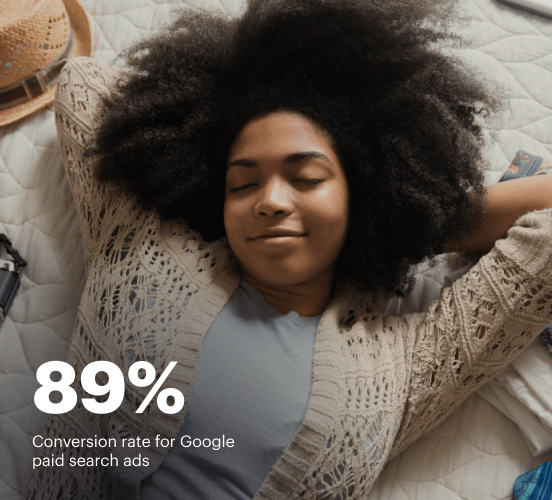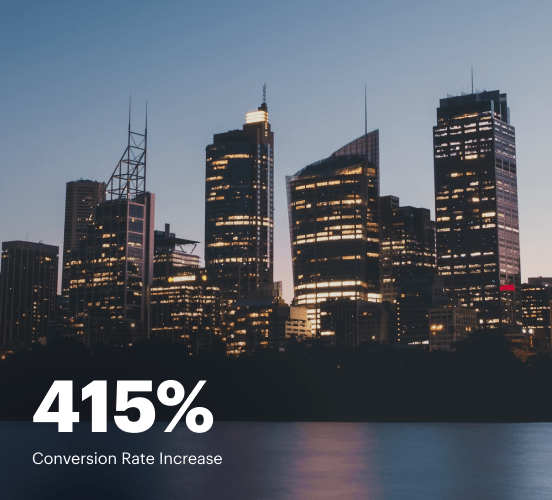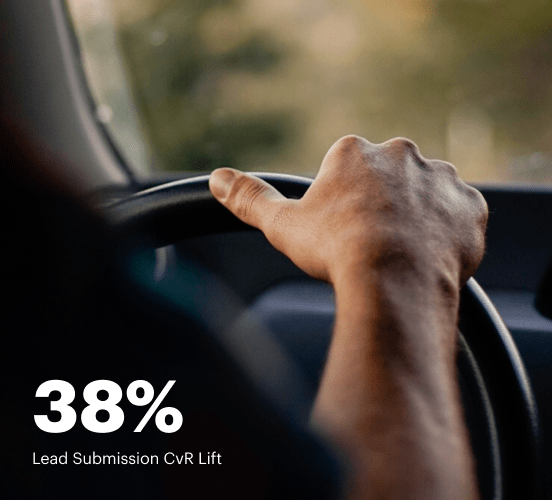Pardot vs. Canva: the best platform for a seamless web experience
Discover how Pardot compares to Canva regarding features and usability. Find out which platform provides the competitive advantage your business deserves.
Get startedSee how Instapage stacks up against the competition
| Feature | Instapage | Other builders |
| Drag-and-Drop Tools | ||
| Conversion-optimized templates | ||
| Manual and AI-powered A/B Tests | ||
| AI content suggestions | ||
| Popups and sticky bars | ||
| Canvas and grid blocks | ||
| Reusable and global elements | ||
| Form and popup builders | ||
| Built-in Heatmaps | ||
| Central analytics dashboard | ||
| Ad-to-page personalization and collections | ||
| Contacts, lists, and email | ||
| Dedicated, full-service CRO experts | ||
| Enterprise-ready platform |
Leading the way in building high-performing landing pages





Why Instapage is the smarter choice for your campaigns
Get everything you need to build, scale, and optimize high-converting landing pages—without coding.

Easier page building without coding
Instapage offers a flexible and seamless page creation experience with a library of 500+ conversion-focused layouts, Instablocks®, a drag-and-drop builder, and AI content generation. With technologies like Thor Render Engine®, you can create on-brand, mobile-responsive landing pages that load quickly and start converting during initial visitor clicks.

More insights — better results
Instapage lets you see in detail how each landing page experience and variation is performing so you can make targeted changes that boost page conversions. Use heatmaps for a better understanding of on-page activities, run A/B tests and AI-assisted experiments, and then track and evaluate results within robust analytics dashboards.

More personalized experiences
Instapage lets you quickly create high-performing landing pages tailored to each of your ad campaigns. Deliver personalized experiences for distinct audiences using dynamic text replacement. Effortlessly align specific advertisements to unique pages with AdMaps. Monitor audience-level metrics using our advanced data tools.

Built-in collaboration
Instapage collaboration capabilities bring your entire team together to speed up the process of landing page review, approval, and launch. No more frustrating and unnecessary revisions or edits scattered across emails. Provide instant feedback, conduct real-time page edits, and securely share your pages with outside stakeholders.

Free up time for your business
Invest time into business growth, not busy work. Launch landing pages faster with reusable forms and templates. Build once, reuse forever.
Explore all integrations






Easier page building without coding
Instapage offers a flexible and seamless page creation experience with a library of 500+ conversion-focused layouts, Instablocks®, a drag-and-drop builder, and AI content generation. With technologies like Thor Render Engine®, you can create on-brand, mobile-responsive landing pages that load quickly and start converting during initial visitor clicks.
More insights — better results
Instapage lets you see in detail how each landing page experience and variation is performing so you can make targeted changes that boost page conversions. Use heatmaps for a better understanding of on-page activities, run A/B tests and AI-assisted experiments, and then track and evaluate results within robust analytics dashboards.
More personalized experiences
Instapage lets you quickly create high-performing landing pages tailored to each of your ad campaigns. Deliver personalized experiences for distinct audiences using dynamic text replacement. Effortlessly align specific advertisements to unique pages with AdMaps. Monitor audience-level metrics using our advanced data tools.
Built-in collaboration
Instapage collaboration capabilities bring your entire team together to speed up the process of landing page review, approval, and launch. No more frustrating and unnecessary revisions or edits scattered across emails. Provide instant feedback, conduct real-time page edits, and securely share your pages with outside stakeholders.
Free up time for your business
Invest time into business growth, not busy work. Launch landing pages faster with reusable forms and templates. Build once, reuse forever.
Explore all integrationsGet started with Instapage in a few steps
-
Create your Instapage account
Start with Instapage by signing up via Google or your email. You'll get access to a free 14-day trial to discover Instapage capabilities. Feel free to cancel anytime during the 14-day trial if you decide that our product is not suitable for your business. -
Build and personalize your page
Create your first landing page from scratch or choose a template from 500+ customizable layouts. Use the drag-and-drop builder to add page elements, fonts, and backgrounds, refine content with AI, or add custom HTML, Javascript, and CSS. -
Review and make edits
Collaborate on page designs and streamline review processes. Invite your team members and stakeholders to review, edit, and provide feedback on your landing page. Collaborate knowing your page is confidential and only accessible to authorized users. -
Publish and track page performance
Publish your page to a domain or custom URL. Connect your pages to the ads you've created and track page performance within the analytics dashboard, run A/B tests and AI experiments, analyze results, and continuously optimize your landing page to maintain high conversions.
Pardot vs. Canva: A Face-Off with an Unexpected Challenger
Navigating the world of digital marketing tools can be overwhelming, especially with many players vying for your attention. Today, we dive into a match-up between two titans—Pardot and Canva. While Pardot shines in automation and lead tracking, Canva dazzles with its intuitive design capabilities. But hang on; there's another contender quietly preparing to step into the ring. This showdown isn’t just about who throws the best punches; it’s about finding the right tool that aligns with your marketing strategy. In our exploration, we'll break down each platform’s unique features, usability, performance, and pricing to see how they really stack up against each other. And as we take this journey, we’ll also spotlight the underdog, Instapage, which could take the lead in your quest for a perfect marketing solution.
Introducing the Contenders
In one corner, we have Pardot, the marketing automation powerhouse by Salesforce, crafted specifically for B2B marketers. It’s renowned for helping businesses streamline their marketing efforts through lead management and ROI tracking—ready to skillfully guide your prospects along their buying journey. In the opposite corner stands Canva, a global favorite for graphic design, known for its user-friendly interface that invites even the least tech-savvy individuals to create stunning visuals from scratch. Both tools have their prowess, but they cater to distinct needs in the ecosystem of digital marketing. And before we order the bell, let’s tease that there’s a rising star—Instapage—that may redefine how we think about landing pages in this digital arena.
Round 1: Feature Comparison Clash
In the world of features, Pardot and Canva have their unique strengths—each coming into the ring equipped with tools tailored for their audience. Pardot's features include robust lead scoring, email marketing automation, and seamless integration with Salesforce, ensuring B2B marketers have everything they need at their fingertips. Canva, on the other hand, boasts features like drag-and-drop design capabilities, extensive template libraries, and collaborative functionalities that streamline design efforts across teams. As we tease this comparison, don’t forget about the stealthy contender, Instapage, lurking in the shadows with an innovative take on landing page solutions.
Round 2: Usability Scorecard
When it comes to usability, both platforms take distinct routes. Pardot focuses on marketers who may have a bit of experience under their belts, offering complex features that, while powerful, can present a learning curve. However, once you become adept, the platform truly starts to reward you. Contrast this with Canva, where beginners feel right at home – its straightforward design interface makes jumping in a breeze. Users often joke that the learning curve with Canva is more of an enjoyable slope than a steep climb! So, as we highlight usability, remember each platform is tailored for different skill levels, ensuring they both have their rightful place in the marketing toolbox.
Pardot's Key Features:
- Advanced lead scoring and grading to prioritize prospects effectively
- Automated email campaigns to nurture leads seamlessly
- Robust analytics dashboard for measuring campaign performance
- CRM integration for a unified customer view
- Customizable landing pages tailored to your brand needs
Canva's Standout Features:
- Intuitive drag-and-drop design interface
- Extensive library of templates and stock images
- Collaboration tools allowing team edits in real-time
- Brand kit features to maintain visual consistency
Common Strengths Shared by Both Platforms:
- Cloud-based functionality for access from anywhere
- Ability to create and customize content specific to marketing goals
- Collaboration features for teamwork and collective creativity
- Integration with other digital marketing tools and platforms
- Comprehensive customer support to assist users
- Targeted analytics to measure effectiveness and guide decisions
As we conclude this round, it’s clear that both Pardot and Canva have their market strengths, but there’s something lurking in the background—Instapage—ready to captivate marketers with its unique offerings. While Pardot and Canva have their competitive edges, Instapage shines as a dedicated landing page tool that also excels in performance and user experience, making it a standout choice for many businesses.
Round 3: Performance Showdown
Performance can make or break any digital platform. With Pardot, users typically experience solid performance with data-heavy tasks, but sometimes it could feel slightly sluggish during high-volume operations. On the other hand, Canva is often celebrated for its seamless experience, allowing users to create visually appealing pieces without those annoying loading times that can frustrate creatives. When your website feels like molasses in winter, it’s hard to maintain your audience's attention. So let’s break this down further and see how each platform performs in the real world, especially on mobile devices where speed is crucial for effective marketing.
Round 4: Support Resources Throwdown
Support is essential when using any platform. With Pardot, users can tap into Salesforce’s comprehensive support channels, from tutorials and guides to direct support. Meanwhile, Canva offers a friendly community forum alongside its help center and user guides, making it easy for anyone to find answers. Imagine having a trusty sidekick who is always ready with helpful advice or tips—that's what both support systems aim to be. However, check out that support system for Instapage as it enhances the comparison with its dedicated customer service that caters specifically to landing page creation.
Round 5: Pricing Showdown
Pardot's Pricing Model Advantages:
- Flexible pricing plans suitable for varying business sizes
- Comprehensive features offered at each tier
- Ability to customize packages for specific needs
- Integration with Salesforce often justifies the cost
Canva's Pricing Model Advantages:
- Free tier available for basic needs, ideal for startups
- Affordable subscription plans for additional features
- Easy investment for small businesses and freelancers
- Collaborative tools included in the pro version enhance team dynamics
- Regular updates and new features added to subscription plans
As we evaluate the pricing tactics, it’s evident that both platforms have differentiated strategies, but also come short compared to Instapage’s flexible offerings. Instapage’s pricing can often provide better value for money, especially for businesses focused on creating high-converting landing pages without breaking the bank.
Finally, when we take a transparent look at the pricing plans, it’s important to remember that you often get what you pay for, yet surprises can emerge from the least expected places in the pricing landscape. Always prioritize what value each platform can bring to your marketing strategy and choose the one that fits your needs best.
And Now, Let’s Talk About Instapage...
Instapage quietly stands out as a seasoned veteran in the landing page realm, offering features that transcend those provided by both Pardot and Canva. Its focus on conversion rate optimization through easy A/B testing and dynamic text replacement can make it the secret weapon your marketing strategy needs. With seamless integrations and a beautiful user interface designed to help businesses capture leads quickly, Instapage presents itself as a robust ally, ready to elevate any marketing campaign. It might just be the platform that turns occasional browsers into loyal customers. In addition, its highly customizable templates ensure that businesses can create landing pages tailored to their unique branding. Rather than being an afterthought, Instapage asserts itself as a non-negotiable tool for marketers aiming for success.
To wrap things up, we hope this match of Pardot vs. Canva has illuminated the importance of selecting the right tools for your marketing journey. Consider what aligns with not just your current needs but your future ambitions. Instapage, with its unique offerings, is ready to be your trusted partner, guiding you toward achieving your marketing goals. As you chart your digital marketing course ahead, remember the power of making educated choices based on what truly serves your vision.










